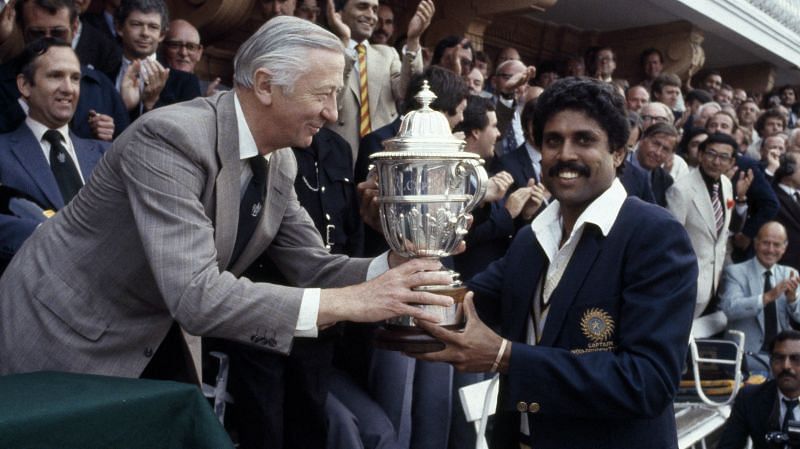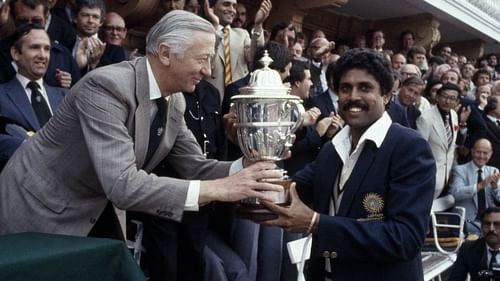
1983 World Cup triumph - An everlasting flame of Indian cricket

This day, that year – 25th June 1983 will be forever etched in the memories of Indian cricket fans. Probably, after Independence, this must be the only second occasion when Indians truly rose up in jubilation. Kapil Dev and his team of daredevils defended a modest score of 183 to bring home the Prudential World Cup. Kids who were born in the era of 80s grew up hearing tales of Kapil Dev. Cricket, by then completely turned into a craze for the 1 billion plus populous country.
For the next few years, India continued to bask in the glory of its historic win. Doordarshan, the national television channel often flanked that incredible moment of Kapil Dev lifting the trophy. Guardians of every household used to take pride in introducing Kapil Dev as the national hero to their kids. His heroics were portrayed as something bigger than the Indian freedom struggle.
For a 4-year or 6-year-old child, cricket hardly mattered. But somehow, the spark in the eyes of their guardians motivated them to seed an ambition, i.e. to become a cricketer. For the little kids of the 80s cricket fascinated them as a career stream as they felt the game gives an opportunity to be a national hero and be on television.
With such a transformation, India started defying the classical stereotype of guardians wanting their kids to make a career in engineering, medicine or aviation. Some parents wanted their kids to become the next Sunil Gavaskar and Kapil Dev.
Cricket academies started flourishing in the metros. Schools which started promoting cricket through their curriculum came into prominence. Companies like MRF under the guidance of stalwarts like Dennis Lillie gifted the country with its first ever ‘academy of fast bowling’ called as the ‘MRF Pace Foundation,’ established in 1987.
The 90s saw a fine transition. Sachin Tendulkar, Vinod Kambli, Sanjay Manjrekar became household names. With the rising number of Mumbai cricketers finding their stronghold in the national side, Mumbai turned out to be the cricketing capital of India.
Cricket in the 90s was no longer an average man’s sport. In addition to the big fat paychecks given by the BCCI towards match fees, cricketers were getting signed up for multi-million brands endorsements from India and around the world.
From the period of 1990 to 2000, India participated in 3 World Cups and failed to make any kind of big impression barring their victories over Pakistan. Some of the 1983 World Cup heroes were now full-time commentators or columnists. India failed to emerge as a cricketing super-power in the world stage. South Africa, Australia and even Sri Lanka looked like an indomitable side. Our cricketing infrastructure continued to improve on a year-on-year basis.
India continued to struggle in overseas test series but the fans continued to cheer for their players. In every tournament, fans would turn up in huge numbers hoping the side scripts a miracle scripted by the 1983 squad.
A little later, one of the darkest episodes of Indian cricket came into the light – it was the match-fixing saga. Fans were ruthless this time. The match-fixing saga saw bans being imposed on several Indian cricketers like Manoj Prabhakar, Ajay Jadeja and Mohammed Azharuddin. The commercial value of cricketers crashed like a pack of cards. This meant BCCI could lose a lot of revenue in sponsorships for the coming years.
BCCI had a huge task at hand to regain the belief of the fans. Trust had to be rebuilt and BCCI couldn’t think of a better leader in the form of Sourav Ganguly. Still fondly remembered as one of the ‘best captains of the Indian team’ Sourav Ganguly nearly won the 2003 World Cup for India. Fans were willing to forgive this time. The energetic leader in Sourav Ganguly not only managed to bring the lost fans but transformed Indian cricket as a whole. The whole new face of Team India could now look into the eyes of the opposition on foreign turfs and win crucial matches.
After taking India to a new high, Sourav Ganguly slumped to his personal low when his tiff with India’s then coach, Greg Chappell made national headlines in the media. Under Rahul Dravid’s captaincy when India suffered a first-round exit in the 2007 World Cup, BCCI was quick to take some drastic measures.
The baton of captaincy was now handed over to MS Dhoni with a number of changes in the team. Dhoni outshined his predecessors. In his debut captaincy assignment, MS Dhoni won the World T20 tournament in South Africa. The scars of the 2007 World Cup were now partially healed.
BCCI showing an ample amount of respect to the greatest servants of Indian cricket decided to retain the stalwarts like Sachin Tendulkar, Rahul Dravid and Anil Kumble. Having proved to be the pillars of Indian cricket, these players retired on their own terms.
MS Dhoni continued to excel in all formats of the game and brought home 2011 World Cup. His credentials in winning every possible ICC tournaments speak louder than his personal milestones. In this decade which is currently witnessing its third World Cup, India has only lost two matches in the showpiece events.
This goes in to show the kind of influence MS Dhoni exercised on the past and the current Indian team. It goes without saying that Dhoni is going to remain one of the greatest darlings of Indian cricket.
Today, 35 years later when the Virat Kohli-led team emerge as the frontrunners for the 2019 World Cup, it will be fair to say that Indian cricket is now going through a harmonious phase. After clinching the Under-19 World Cup, India has not only identified a worthy talent pool for the near future but for the coming two generations. The cash-rich IPL is only going to fine-tune the talent pool with time.
The journey of Indian cricket in the past four decades presents a pattern of good and trying times. The biggest inspiration lies in the fact that Indian cricket saw a face-lift after every windfall. The game managed to retain its fan base over the years and continues to remain a sensation for the people.
The period of the crisis was hard-fought. Be it Sachin Tendulkar who remained the batting mainstay in the 90s, Sourav Ganguly who took captaincy after the match-fixing saga or MS Dhoni who conquered every ICC honour, the 1983 World Cup triumph served ample amount of inspiration to these men.
These men took the onus on themselves and transformed Indian cricket when it mattered the most. Bringing such a dramatic shift was never going to be an easy task. Somewhere in the back of their minds, the 1983 World Cup triumph gave them an adrenaline rush to display the same amount of grit and determination of the 1983 World Cup heroes.
India as a cricketing superpower is going to win many coveted titles, but in their ‘book of firsts,’ the 1983 World Cup is always going to serve as an everlasting flame of India cricket.
Also read - Lowest team total in world cup
Follow Sportskeeda for all the updates on World cup points table, news, live scores, most wickets in world cup, schedule, most runs, and fantasy tips.